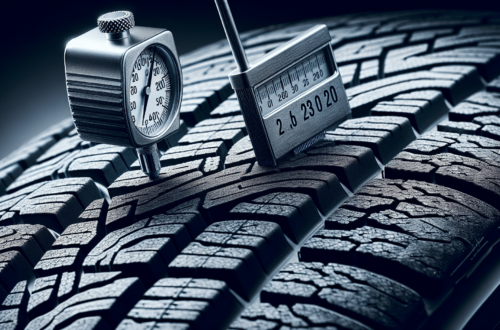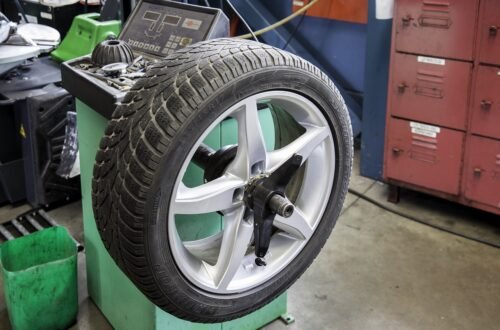When it comes to road safety, there’s an often overlooked aspect that plays a crucial role in keeping you and your loved ones safe: tire tread depth. As the only point of contact between your vehicle and the road, the condition of your tires directly impacts your ability to stay in control, especially in adverse weather conditions. In this article, we’ll explore the importance of maintaining proper tire tread depth and how it contributes to safe driving. So buckle up and get ready to discover the key to staying firmly on the road!
What is tire tread depth?
Definition of tire tread depth
Tire tread depth refers to the measurement of the space between the top surface of the tire tread and the deepest groove. It is an important factor in determining the performance and safety of a vehicle’s tires.
Importance of tire tread depth
Tire tread depth is crucial for safe driving as it directly affects the traction, handling, and braking performance of a vehicle. Having sufficient tread depth ensures that tires can effectively grip the road surface, particularly in wet conditions, minimizing the risk of accidents and enhancing overall stability and control.
Why is proper tire tread depth important?
Traction and grip on wet surfaces
One of the primary reasons for maintaining adequate tread depth is to ensure optimal traction and grip on wet surfaces. The deep grooves and channels on the tire tread allow water to be channeled away from the tire, preventing hydroplaning and increasing the tires’ contact with the road surface.
Prevention of hydroplaning
Hydroplaning occurs when a layer of water builds up between the tire and the road surface, resulting in a loss of traction and control. Sufficient tread depth helps to prevent hydroplaning by efficiently dispersing water and maintaining contact with the road, enabling the tires to grip and maneuver safely.
Improved handling and control
Proper tire tread depth plays a vital role in enhancing a vehicle’s handling and control. The tread pattern allows for better traction during acceleration, cornering, and braking, ensuring that the tires maintain their grip on the road surface and providing the driver with confidence and stability behind the wheel.
Enhanced braking performance
Maintaining adequate tread depth greatly improves a vehicle’s braking performance, especially in emergency situations. The deep grooves in the tire tread allow water, dirt, and debris to be cleared away, allowing the brake pads to make direct contact with the road surface and increasing the effectiveness of braking.
Increased stability and maneuverability
Tire tread depth directly impacts the stability and maneuverability of a vehicle. Tires with worn-out tread have reduced grip, which can lead to unstable handling and compromised maneuverability, particularly on curves and turns. Adequate tread depth ensures stability, allowing drivers to have better control over their vehicle.
Better resistance to punctures
Proper tire tread depth provides better resistance to punctures and damage. The deep grooves and channels in the tread pattern help to deflect sharp objects and reduce the risk of penetration, minimizing the chances of a punctured tire and the inconvenience of a sudden flat tire while driving.

This image is property of images.pexels.com.
How to measure tire tread depth
Using a tread depth gauge
One of the most accurate ways to measure tire tread depth is by using a tread depth gauge. This handheld tool allows for precise measurements in millimeters or inches. Simply insert the probe into the groove of the tire and take the reading. It is recommended to measure at multiple points across the tire to ensure an accurate assessment.
Using the penny test
The penny test is a simple and widely used method to estimate tire tread depth. Take a penny and insert it into the tread groove with Lincoln’s head facing down. If the top of Lincoln’s head is visible, it indicates that the tread depth is too low, and it is time to replace the tire.
Understanding different tread wear indicators
Some tires come equipped with tread wear indicators, also known as wear bars, which can help determine when the tires need to be replaced. These indicators are small raised bars that bridge the gaps in the tread grooves. When the bars are level with the rest of the tread, it indicates that the tire has reached its minimum tread depth and should be replaced.
Legal considerations
Minimum legal tread depth requirements
Different jurisdictions have specific minimum legal tread depth requirements that must be adhered to. In many countries, the minimum tread depth required is around 1.6 millimeters (2/32 of an inch) across the tire’s entire circumference. It is important to familiarize yourself with the legal requirements in your area to ensure compliance.
Penalties for driving with inadequate tread depth
Driving with inadequate tread depth can lead to legal consequences and penalties. In addition to potential fines, driving with insufficient tread depth increases the risk of accidents and jeopardizes the safety of both the driver and other road users.
Responsibility of vehicle owners and drivers
Meticulous tire maintenance is the responsibility of both vehicle owners and drivers. Regularly inspecting and ensuring proper tread depth is not only a legal requirement but also a crucial step in maintaining safe driving conditions. By taking responsibility for tire maintenance, individuals contribute to a safer road environment for everyone.

This image is property of images.pexels.com.
Signs of worn-out tread
Visible tread wear indicators
Tires have built-in tread wear indicators that become visible as the tread wears down. These indicators are often found between the tread grooves and appear as small bars. When these indicators become visible, it is a clear indication that the tire has reached its minimum tread depth and should be replaced promptly.
Uneven tread wear patterns
Uneven tread wear patterns can be another sign of worn-out tread. If the tire has worn down unevenly, it may indicate improper alignment, incorrect tire inflation, or other underlying mechanical issues. Regularly inspecting the tread for any signs of uneven wear will help identify potential problems and allow for timely maintenance or replacement.
Loss of traction and increased stopping distance
When tires have insufficient tread depth, they lose their ability to maintain traction effectively. This loss of traction can be particularly noticeable when accelerating or braking, as the tires struggle to grip the road surface. Additionally, the stopping distance of a vehicle increases with worn-out tread, posing a potential hazard in emergency situations.
Increased risk of hydroplaning
Tires with worn-out tread are more prone to hydroplaning, especially during wet weather conditions. Insufficient tread depth hampers the tire’s ability to disperse water efficiently, leading to reduced traction and an increased risk of losing control of the vehicle on wet surfaces.
Increased road noise or vibration
As the tread wears down, tires produce increased road noise and vibrations. This can be noticed as a humming or vibrating sensation inside the vehicle. Excessive road noise and vibrations indicate that the tires have reached their limit and should be replaced to ensure a quieter and smoother ride.
Proper maintenance to ensure adequate tread depth
Regular visual inspections
Performing regular visual inspections of your tires is an essential part of maintaining adequate tread depth. Look for any signs of visible wear, such as shallow grooves, uneven wear patterns, or exposed tread wear indicators. If any of these signs are present, consult a professional for further evaluation.
Rotation and alignment of tires
Regularly rotating and aligning the tires can help promote even wear and extend their lifespan. This maintenance practice ensures that the tires wear down evenly, preventing premature wear on one side. Proper alignment also ensures that the vehicle travels in a straight line, reducing unnecessary stress on the tires and promoting optimal tread depth.
Maintaining proper tire pressure
Keeping tires properly inflated is crucial for maintaining adequate tread depth. Underinflated tires can cause the edges of the tread to wear down faster, resulting in reduced tread depth. Regularly check the tire pressure using a tire pressure gauge and adjust it according to the manufacturer’s recommendations.
Avoiding overloading the vehicle
Overloading a vehicle puts excessive stress on the tires, accelerating tread wear. It is important to adhere to the recommended load limits specified by the vehicle manufacturer. Avoid overloading the vehicle with heavy items and distribute the weight evenly to minimize the impact on tire wear and tread depth.
Replacing tires when necessary
When the tire tread depth reaches the minimum legal limit, it is time to replace the tires. It is crucial not to delay replacing worn-out tires, as doing so increases the risk of accidents and compromises the safety of the vehicle and its occupants. Consulting with a professional tire dealer or mechanic can help determine the appropriate time for tire replacement.

This image is property of images.pexels.com.
How often should tires be replaced?
Factors affecting tire lifespan
The lifespan of tires can vary depending on several factors, such as driving conditions, maintenance practices, tire quality, and individual driving habits. Generally, tires should be replaced every 6 to 10 years, even if they appear to have sufficient tread depth. However, it is essential to monitor tread depth regularly and replace tires when the depth falls below the legal requirements or when signs of wear and damage are evident.
Guidelines for tire replacement based on tread depth
As a general guideline, tires should be replaced when the tread depth reaches 2/32 of an inch (1.6 millimeters) or less. However, it is recommended to replace tires earlier if driving in wet or snowy conditions, as the decreased traction on such surfaces can greatly affect the vehicle’s safety.
Importance of consulting with a professional
While guidelines and recommendations exist for tire replacement based on tread depth, it is essential to consult with a professional tire dealer or mechanic for a thorough evaluation. They can provide expert advice based on factors specific to your vehicle, driving habits, and local climate conditions, ensuring that you maintain the highest level of safety on the road.
The role of tire tread depth in different driving conditions
Dry pavement
Even on dry pavement, proper tire tread depth plays a significant role in maintaining stability and control. The tread pattern provides the necessary grip and traction, allowing for precise steering, optimal handling, and responsive braking. Adequate tread depth ensures that tires can effectively grip the road, promoting safe driving even under dry conditions.
Wet surfaces
On wet surfaces, the importance of proper tire tread depth becomes even more critical. The channels and grooves in the tread pattern help evacuate water quickly, reducing the risk of hydroplaning and maintaining the tire’s grip on the wet road surface. Sufficient tread depth ensures efficient water dispersion, enhancing traction and minimizing the chances of skidding or losing control.
Snowy or icy roads
In snowy or icy conditions, proper tire tread depth is vital for safe driving. Tires with deep treads provide enhanced traction on slippery surfaces, allowing the vehicle to maneuver more effectively. The tread channels help grip the snow or ice, reducing the chances of sliding or getting stuck. It is essential to check and maintain tire tread depth before venturing out in wintry conditions.
Tips for safe driving with proper tire tread depth
Maintaining a safe following distance
Regardless of tire tread depth, maintaining a safe following distance is crucial for safe driving. By keeping a reasonable distance between your vehicle and the one ahead, you allow yourself ample time to react to sudden stops or other unexpected situations, regardless of the road or weather conditions.
Adapting driving to weather conditions
Driving with proper tire tread depth is just one aspect of safe driving. Adapting your driving style to suit the weather conditions is equally important. Reduce your speed, increase the following distance, and avoid sudden maneuvers, particularly in adverse weather conditions like rain or snow. This will help ensure that your tires can maintain grip and traction on the road.
Avoiding sudden acceleration and braking
Sudden and aggressive acceleration or braking can lead to skidding and loss of control, especially if the tire tread depth is already compromised. To maintain optimal tire performance, avoid abrupt acceleration and braking when driving, as it puts unnecessary stress on the tires and reduces their ability to maintain traction.
Properly maintaining and replacing tires
Regular maintenance of tires, such as maintaining proper inflation, rotating, and aligning them, is crucial for extending their lifespan and ensuring optimal tread depth. Additionally, promptly replacing tires when they reach the minimum tread depth or show signs of wear and damage is essential for safe driving.
Conclusion
In conclusion, tire tread depth plays a pivotal role in ensuring safe driving. It affects various aspects of a vehicle’s performance, including traction, handling, braking, stability, and maneuverability. It is crucial for drivers to regularly inspect and maintain adequate tread depth, as worn-out tread can compromise safety and increase the risk of accidents. By emphasizing the importance of proper tire tread depth, promoting regular maintenance and inspections, and adhering to legal requirements, we can contribute to a safer and more secure driving experience for everyone on the road.





